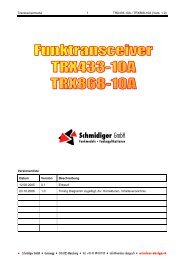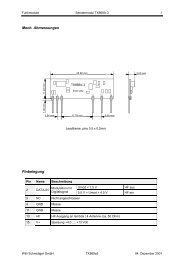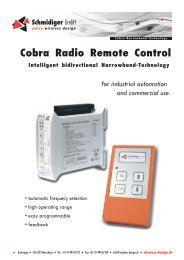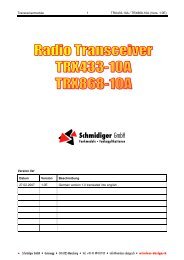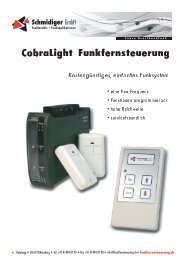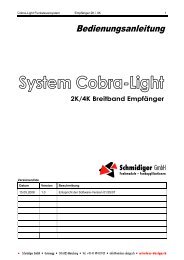Version List
Version List
Version List
You also want an ePaper? Increase the reach of your titles
YUMPU automatically turns print PDFs into web optimized ePapers that Google loves.
Transceiver module TRX433-10C2 / TRX868-10C2 (Vers. 1.0E) 27<br />
Instruction set (<strong>Version</strong> C2)<br />
To configure the transceiver you have to set the MODE-Pin high. Thereby, the transceiver is set into the<br />
configuration mode and can be configured over the serial interface (Pin 10, TxD and Pin 11, RxD).<br />
The serial data type is N, 8, 1 (no parity, 8 data bits, 1 stop bit). The baud rate can be chosen freely in the<br />
configuration mode because the transceiver detects following baud rate automatically: 1.2kBaud, 2.4kBaud,<br />
4.8kBaud, 9.6kBaud, 19.2kBaud, 38.4kBaud, 57.6kBaud and 115.2kBaud (115.2kBuad requires a 16MHz<br />
µP clock frequency).<br />
Command structure<br />
A command is always made out of 3 bytes:<br />
Command byte 1 Command byte 2 Command byte 3<br />
Starting signal [0B0H] Function [00H…0FFH] Parameter or level [00H…0FFH]<br />
A transceiver will acknowledge a correct received command with an answer within 2ms (respectively 10ms<br />
by commands that are stored in EEPROM) if the transceiver is still in configuration mode at the time of the<br />
answer (MODE-pin on high). The answer is mostly out of two bytes but can include more data, depending on<br />
the command:<br />
Answer byte 1 Answer byte 2 Answer byte 3…..n<br />
Function respectively<br />
echo of command byte 2<br />
Value [00H…0FFH] Value [00H…0FFH]<br />
number of bytes depends on function<br />
Starting signal<br />
The starting signal marks the beginning of a command frequency and has to have the value 0B0H.<br />
Notes:<br />
• The three bytes have to be transmitted to the transceiver within max. 200ms so that a command is<br />
identified as such.<br />
• When a transceiver doesn’t recognize a valid command or recognizes a command with a wrong<br />
parameter then it returns an error code in the used baud rate. See paragraph error code.<br />
Configuration in the RAM or EEPROM<br />
The transceiver starts with the in the EEPROM saved configuration (RS232, baud rate, radio frequency, RF<br />
data rate etc.) in case of receiving the following event:<br />
• Power up<br />
• MCLR\ Reset<br />
• Wakeup after sleep when Reset is configured after sleep<br />
Afterwards, any parameter can be changed with the WRITE-function. The change is activated immediately<br />
after the command.<br />
Is the Bit7 of the function (Byte 2) set in the WRITE-commands 08H...1FH, then the configuration is saved in<br />
the RAM and additionally stored permanently in the EEPROM. When the Bit7 is deleted, then the<br />
configuration is only saved in the RAM and isn’t available anymore after a power up.<br />
Bit7 isn’t important to all the other commands (outside 08...1FH) and it is therefore ignored.<br />
The answer to a command is always sent back with a deleted Bit7, no matter if Bit7 was set or not in the sent<br />
command.<br />
Important notice: The EEPROM has a limited number of 100’000 write cycles per parameter. Therefore the<br />
often changing parameters (e.g. frequency change by frequency – hopping systems) may only be stored in<br />
the RAM.



